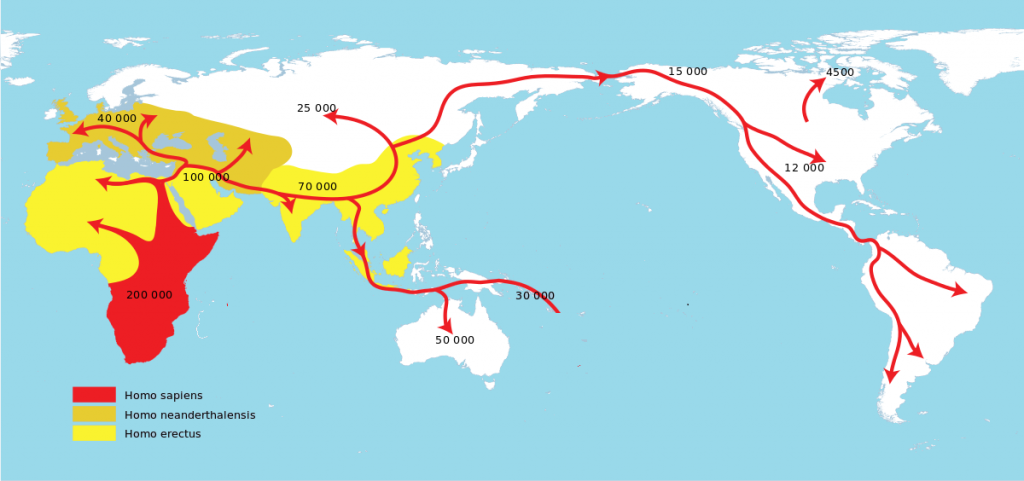Ancient humans migrated out of Africa three times. The first âOut of Africaâ as archaeologist Peter Bellwood explains in First Migrants, was about 2 million years ago, long before our own species, Homo sapiens, had emerged. But one of our ancestors, Homo erectus and other, related species entered Southwest Asia from East Africa, and settled in most of tropical and temperate Eurasia. They walked completely upright, made stone tools and hunted and gathered for a living. They had small brains, just 500 to 900 cc, half the size of ours (about 1500 cc). H. erectus also lacked the imagination which inspires humans today. Homo erectus never invented boats to reach the islands and itâs not clear if they could make clothing to keep warm.
Out of Africa 2 occurred around a million years ago. A second human species migrated from Africa, Homo heidelbergensis, which eventually evolved into the famous Neanderthals of Europe (Homo neanderthalensis). Another branch of Homo heidelbergensis stayed in Africa, where they eventually evolved into Homo sapiens.
Out of Africa 3 was sometime between 200,000 and 130,000 years ago, when Homo sapiens, fully modern humans, left Eastern and Southern Africa to conquer the Earth. It was a humble start, with just a few people. Estimates vary, but there may only have been as few as 10,000 breeding adults on the whole planet.
By this time, modern humans almost certainly spoke fully expressive languages: they could no doubt argue, bend the truth, and describe their dreams. We donât know the words they used to give flight to their thoughts, since their languages are lost in time. Long before people had started to till the earth, from 130,000 to 50,000 years ago, these hunter-gatherers had replaced the Neanderthals, with just a bit of genetic mixing in Eurasia. Humans on most continents derive some two to four percent of their genes from Neanderthals. Modern Africans are largely free of Neanderthal genes.
Homo sapiens settled all of Africa, Eurasia and Australia. Periodic ice ages with lower sea levels created land bridges to Britain, Japan, and many of the islands of Southeast Asia. These modern humans had the imagination to invent boats, and they crossed a stretch of 70 km of open sea to reach New Guinea and Australia.
Before 16,000 years ago people had mastered cold weather survival, almost certainly sewing sophisticated clothing from animal hides, using bone needles that have been found in archaeological sites. By then, some had reached the Eurasian Arctic and crossed the wide Beringia Land Bridge into Alaska. By 11,000 years ago, people were already hunting guanacos in southern South America. People had either walked down the South American coast or taken boats.
Boats were also crucial for reaching the islands of Melanesia, as far east as the Solomon Islands.

So, before humanity ever started to farm, our ancestors had reached almost every inhabitable spot on Earth, with the exception of the Eastern Pacific, which came much later. By 10,000 years ago, modern humans had migrated vast distances from Africa, settling all the continents, from the tropics to the Arctic, except for Antarctica.
By 10,000 years ago our ancestors could paint great art, carve ivory figurines, and invent tailored clothing. Their art included naturalistic representations of animals, but also dots, lines, half-circles and other abstract symbols, suggesting that they also had complex language. When their imagination got the better of their sense of caution, our ancestors would also walk or sail over the horizon.
There were only slight genetic differences between populations. In colder latitudes, where people wore fur suits most of the time, they struggled to synthesize enough vitamin D from the sun. Evolution selected for lighter skin, to help folks get their vitamins. Other than that, white skin doesnât mean much more than the ability to get a sunburn.
From prehistory we learn that Africa was the cradle of humanity. The early modern humans were creative, thoughtful and widespread yet still relied on hunting and gathering for food and other essentials. Next week I will discuss the second half of First Migrants, which covers early agriculture and the movements of the first farmers.
Further reading
Iâve taken most of this material, especially the outline of prehistoric migrations from:
Bellwood, Peter 2013 First Migrants: Ancient Migration in Global Perspective. Oxford, UK: Wiley-Blackwell.
Iâve also been inspired by some recent books that document how most of humankindâs genetic differences are literally skin deep, while our common humanity goes all the way to our core.
Mukherjee, Siddhartha 2016 The Gene: An Intimate History. Penguin Books: Haryana, India.
Zimmer, Carl 2018 She Has Her Motherâs Laugh: The Powers, Perversions and Potential of Heredity. New York: Dutton. 656 pp.






